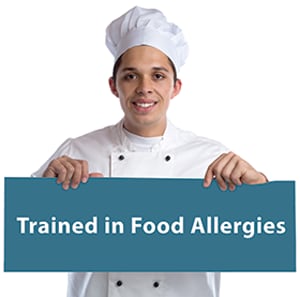Restaurants Can Reduce the Risk of Food Allergy Reactions
Key Takeaways from Our Research
We found gaps in restaurant knowledge and practices about food allergies. However, restaurants and environmental health programs can work to reduce the risk of customer food allergic reactions in their restaurant.

Taking the following steps can prevent allergic reactions:
- Train staff on food allergies, especially less experienced staff. Many restaurants had staff who had not received training on food allergies and lacked key knowledge about allergens. Staff with less experience in the restaurant had less knowledge about allergies.
- Use separate equipment and areas to prepare and cook meals for customers with food allergies, when feasible. Many restaurants did not prepare allergen-free food on separate equipment or surfaces. If a separate cooking or prep area is not available, the person cooking should thoroughly wipe down surfaces and wash equipment before preparing food for customers with allergies.
- Provide ingredient lists or recipes for menu items. Some restaurants did not have lists of ingredients or recipes available for their menu items.
- Have a plan for serving customers with food allergies. Restaurant staff knew more about food allergies if they worked in restaurants with a plan for serving customers with food allergies.
Food allergies are common in restaurants. Many food allergic reactions occur in restaurants, and one in three people with food allergies report having a reaction in a restaurant. Understanding restaurant practices to address food allergies and what food workers know about them can help reduce the risk of food allergic reactions in restaurants.
The Environmental Health Specialist Network wanted to describe staff knowledge and attitudes about food allergies. We interviewed and watched restaurant managers, food workers, and servers, and we looked at related records at restaurants to find out how many restaurants
- train their staff on food allergies,
- have ingredient lists available for customers, and
- provide special equipment and areas for making food for customers with food allergies or require that staff wipe down work surfaces and wash equipment before making said food.
Staff knew more about food allergies if they
- Worked in restaurants with a plan for serving customers with food allergies.
- Had more experience in their restaurant.
Restaurant managers and staff were generally knowledgeable and had positive attitudes about accommodating customers’ food allergies, but more than half of the staff we interviewed had never been trained on food allergies.
- Training often did not cover important information such as what to do if a customer has an allergic reaction.
- Some managers and staff incorrectly believed someone with a food allergy could safely eat a small amount of that allergen.
- Some staff thought others in their restaurant might not know what to do if a customer had an allergic reaction.
Most restaurants had lists of ingredients or recipes available for some or all their menu items, but most restaurants did not have separate areas and equipment for preparing and cooking allergen-free food. These are key practices that can help customers with food allergies.
Scientific articles this plain language summary is based on:
- Restaurant Food Allergy Practices – Six Selected Sites, United States, 2014
- Food Allergy Knowledge and Attitudes of Restaurant Managers and Staff: An EHS-Net Study [PDF – 176 KB]
Food Allergens Study (study information)
Preventing Food Allergies in Restaurants (blog)
More EHS-Net publications by Study Topic
This study was conducted by the Environmental Health Specialists Network (EHS-Net). EHS-Net is a federally funded collaboration of federal, state, and local environmental health specialists and epidemiologists working to better understand environmental causes of foodborne illness.